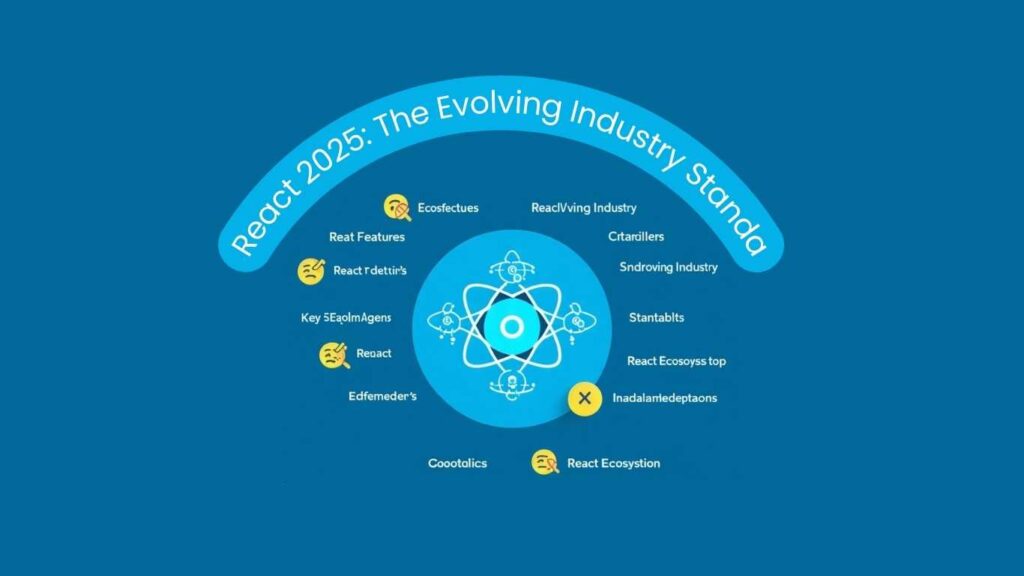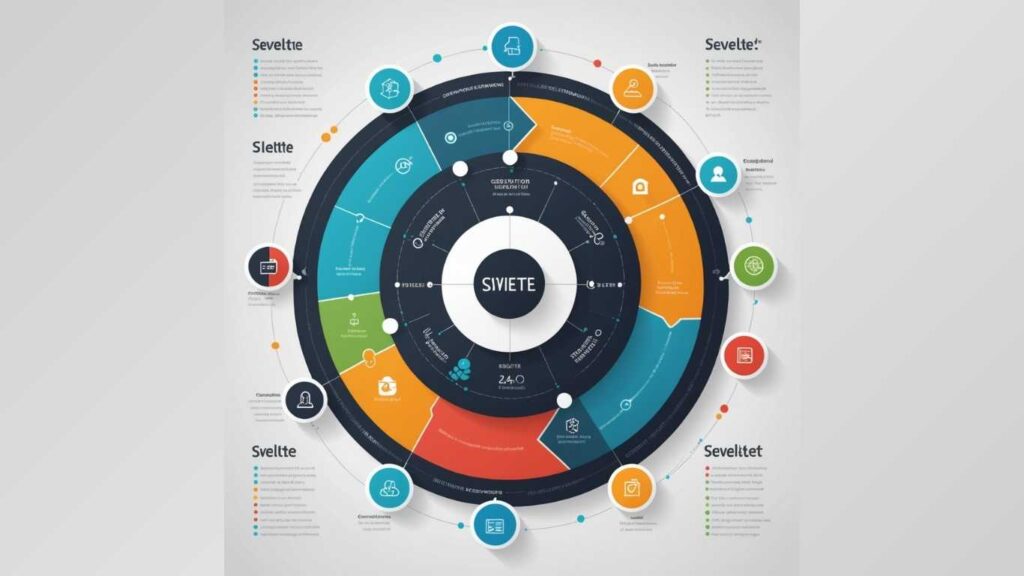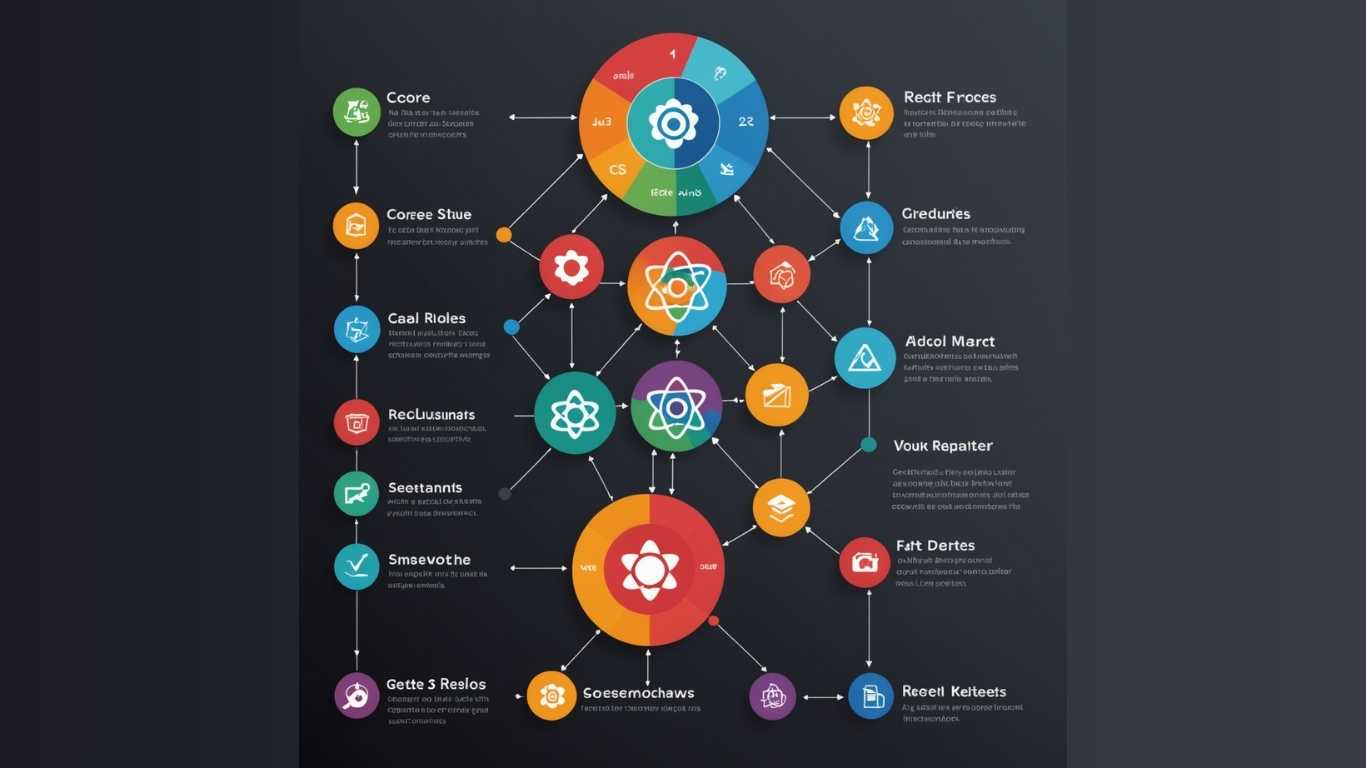The Evolution of Modern Frontend Frameworks and JavaScript Libraries
The landscape of frontend frameworks and JavaScript libraries has dramatically transformed the web development ecosystem. As we navigate through 2025, developers face an ever-expanding array of options for building modern, responsive, and performant web applications. This comprehensive guide explores the top 5 modern frontend frameworks and libraries dominating the industry, helping you make informed decisions for your next web development project.
Frontend development continues to evolve at a rapid pace, with new tools emerging and existing frameworks refining their capabilities. Whether you’re building complex enterprise applications or lightweight consumer websites, choosing the right frontend tech stack is crucial for development efficiency and application performance.
Table of Contents
1. React 2025: The Evolving Industry Standard

React has maintained its position as the most widely adopted JavaScript framework in the frontend ecosystem, but React 2025 brings significant advancements that cement its leadership position among modern frontend technologies.
Key Features of React 2025
- Server Components: React 2025 has fully embraced server components, allowing developers to render components on the server without sending JavaScript to the client, dramatically improving performance for content-heavy applications.
- Concurrent Rendering: The concurrent mode is now the default rendering strategy, enabling React to work on multiple UI updates simultaneously without blocking the main thread.
- Automatic Batching: React 2025 intelligently batches state updates across your entire application, reducing unnecessary re-renders and improving performance.
- Streaming SSR: Enhanced server-side rendering capabilities allow content to stream to the client progressively, improving perceived loading performance.
- Simplified Data Fetching: New built-in data fetching primitives reduce the need for third-party libraries for common data operations.
React Ecosystem in 2025
React’s ecosystem of frontend libraries continues to thrive:
- Redux Toolkit: Still relevant for complex state management scenarios, though React’s built-in capabilities have reduced its necessity for simpler applications.
- React Query 6.0: The go-to solution for server state management with enhanced TypeScript support and performance optimizations.
- Styled Components/Emotion: These CSS-in-JS libraries remain popular for component-scoped styling in React applications.
- React Testing Library: The standard for testing React components with a user-centric approach.
“React 2025 has successfully balanced innovation with backward compatibility, allowing teams to incrementally adopt new features while maintaining existing codebases.” – Frontend development expert
2. Next.js: The Complete React Framework

Next.js has evolved from a React framework focused on server-side rendering to a comprehensive platform for building web applications of all sizes. As one of the best UI frameworks available in 2025, Next.js continues to innovate while maintaining developer experience as a top priority.
Key Features of Next.js in 2025
- App Router: The App Router introduced in Next.js 13 has become more refined, offering an intuitive file-system-based routing with enhanced features for layouts, loading states, and error boundaries.
- React Server Components Integration: Next.js provides first-class support for React Server Components, allowing developers to build hybrid applications with optimal client/server architecture.
- Edge Runtime: Next.js leverages edge computing capabilities for faster global deployments with reduced latency.
- Image and Font Optimization: Built-in components for optimizing media assets continue to evolve, now with AI-enhanced image processing capabilities.
- Turbopack: The Rust-based successor to Webpack has fully matured, offering lightning-fast builds and development experience.
Use Cases for Next.js
Next.js excels in various scenarios:
- E-commerce platforms require SEO optimization and fast page loads
- Content-rich websites with frequent updates
- Web applications with complex authentication and authorization flows
- Enterprise dashboards require both performance and developer productivity
“Next.js has become the default choice for React projects that need to balance performance, SEO, and developer experience. Its integration with Vercel provides an unmatched deployment experience.” – Web development tools specialist
3. Vue.js 4.0: The Progressive JavaScript Framework

Vue.js has maintained its position as a developer-friendly frontend framework that offers a gentle learning curve without sacrificing power. Vue.js 4.0 brings significant improvements while staying true to its progressive adoption model.
Key Features of Vue.js 4.0
- Enhanced Reactivity System: Vue.js 4.0 introduces an even more efficient reactivity system with improved performance for large-scale applications.
- Vapor Mode: A new compilation mode that reduces runtime overhead by generating highly optimized render functions.
- Script Setup Syntax: The Composition API
<script setup>has become the standard way to write Vue components, offering better TypeScript integration and IDE support. - Suspense and Teleport Components: These built-in components have been refined for better handling of async operations and portal-based UI elements.
- Improved TypeScript Integration: First-class TypeScript support is now seamless, with better type inference and developer tooling.
Vue.js Ecosystem in 2025
The Vue.js ecosystem offers a comprehensive set of frontend libraries:
- Pinia: The official state management solution has replaced Vuex entirely, with a simpler API and better TypeScript support.
- Vue Router 5: Redesigned to work seamlessly with the Composition API and offering improved performance.
- VueUse: A collection of essential Vue composition utilities that has become the standard library for Vue developers.
“Vue.js 4.0 strikes the perfect balance between developer experience and performance. Its progressive nature allows teams to adopt it incrementally, making it ideal for both new projects and migrations.” – Vue.js core team member
4. Svelte: The Compiler-First Lightweight Framework

Svelte has disrupted the traditional approach to frontend frameworks by shifting much of the work from runtime to build time. In 2025, Svelte has gained significant market share as developers seek lightweight frameworks that prioritize performance.
Key Features of Svelte in 2025
- No Virtual DOM: Svelte compiles components to highly optimized vanilla JavaScript that directly manipulates the DOM, resulting in exceptional performance.
- Truly Reactive: Svelte’s fine-grained reactivity system updates only what needs to change, without the overhead of diffing algorithms.
- Minimal JavaScript Payload: Applications built with Svelte typically ship less JavaScript to the browser compared to other frontend frameworks.
- Built-in Transitions and Animations: Svelte makes creating smooth UI transitions remarkably simple with built-in animation capabilities.
- Stores for State Management: Svelte’s built-in stores provide a simple yet powerful way to manage application state without additional libraries.
SvelteKit: The Full-Featured Svelte Framework
SvelteKit has matured into a production-ready framework that provides:
- Filesystem-based Routing: Intuitive routing similar to Next.js but with Svelte’s compiler advantages.
- Server-Side Rendering and Static Site Generation: Flexible rendering options for optimal performance and SEO.
- Edge Functions: Serverless function capabilities for API routes and server-side logic.
- Adapter System: Easy deployment to various platforms through a pluggable adapter system.
“Svelte represents the future of frontend frameworks with its compiler-first approach. The performance benefits are undeniable, and the developer experience is exceptional for teams willing to adopt a slightly different mental model.” – Performance optimization expert
5. Angular 17+: The Enterprise-Grade Framework

Angular continues to be a powerhouse for enterprise applications, with version 17 and beyond significantly improving performance and developer experience. As a complete frontend framework, Angular provides everything teams need to build complex applications.
Key Features of Angular in 2025
- Standalone Components by Default: Angular has fully embraced standalone components, simplifying the application structure and reducing the need for NgModules.
- Signals for Reactivity: The new reactivity system, based on signals, provides more granular control over change detection, significantly improving performance.
- Hydration and Partial Hydration: Enhanced server-side rendering with intelligent hydration strategies reduces time-to-interactive.
- Improved Build Performance: The Angular CLI now leverages esbuild and other modern build tools for faster compilation.
- Directive Composition API: A more flexible way to compose and reuse directive logic across components.
Angular Ecosystem in 2025
Angular’s comprehensive ecosystem includes:
- Angular Material: The official component library has been redesigned with better performance and customization options.
- NgRx: The Redux-inspired state management library has simplified its API while maintaining its powerful features.
- Angular Universal: Server-side rendering capabilities have been more deeply integrated into the core framework.
“Angular remains the go-to choice for enterprise teams that value structure, consistency, and comprehensive tooling. The improvements in performance and developer experience have addressed previous criticisms while maintaining its strengths.” – Enterprise architecture consultant
Honorable Mentions: Other Notable Frontend Tech in 2025
Qwik: The Resumable Framework
Qwik has gained traction with its innovative approach to hydration. Instead of re-executing JavaScript on the client, Qwik serializes the application state and “resumes” where the server left off, resulting in near-instant interactivity regardless of application size.
Solid.js: Fine-Grained Reactivity
Solid.js combines React-like JSX syntax with a truly reactive system that updates only what changes. Its minimal runtime and excellent performance metrics make it a compelling alternative for performance-critical applications.
Astro: The Content-Focused Framework
Astro has carved out a niche for content-heavy websites with its “islands architecture approach, allowing developers to use their preferred frontend libraries while shipping minimal JavaScript to the browser.
Nuxt.js 4: The Vue Framework
Nuxt.js continues to be the premier framework for Vue.js applications, offering similar capabilities to Next.js but within the Vue ecosystem. Nuxt 4 brings improved performance, better TypeScript support, and enhanced developer experience.
Choosing the Right Frontend Framework in 2025
Selecting from the best UI frameworks and frontend libraries requires careful consideration of several factors:
Project Requirements
- Application Complexity: More complex applications might benefit from the structure of Angular or the comprehensive nature of Next.js.
- Performance Requirements: If raw performance is critical, Svelte or Solid.js might be better choices.
- SEO Needs: Frameworks with strong SSR capabilities like Next.js, Nuxt.js, or SvelteKit are ideal for content that needs to be indexed.
Team Experience and Preferences
- Learning Curve: Vue.js and Svelte generally offer gentler learning curves compared to React or Angular.
- Existing Expertise: Leveraging your team’s existing knowledge can accelerate development.
- Community and Support: Larger frameworks like React and Angular have more resources and community support.
Ecosystem and Tooling
- Available Libraries: Consider the ecosystem of frontend libraries that integrate with your chosen framework.
- Build Tools and Performance: Evaluate the development experience and build performance.
- Testing Infrastructure: Some frameworks have more mature testing ecosystems than others.
Frontend Development Trends in 2025
Several trends are shaping the future of frontend frameworks and web development tools:
1. Server Components and Hybrid Rendering
The line between client and server rendering continues to blur, with frameworks adopting hybrid approaches that optimize for both performance and interactivity.
2. AI-Enhanced Development
AI tools are increasingly integrated into frontend development workflows:
- Automated code generation tailored to specific frameworks
- Intelligent refactoring suggestions
- Automated accessibility and performance optimizations
- UI generation from design files or natural language descriptions
3. WebAssembly Integration
Frontend frameworks are leveraging WebAssembly for performance-critical operations:
- Image and video processing
- Complex calculations and algorithms
- Gaming and interactive experiences
- Porting existing C++ or Rust libraries to the web
4. Edge Computing
The shift toward edge computing is influencing how frontend applications are architected:
- Rendering closer to users for reduced latency
- Distributed state management
- Edge-aware data fetching strategies
Conclusion: The Future of Modern Frontend
The frontend development landscape in 2025 offers more choices than ever before, with each framework and library bringing unique strengths to the table. React 2025 continues to dominate with its extensive ecosystem and continuous innovation. Next.js provides a comprehensive solution for React developers seeking a complete framework. Vue.js 4.0 maintains its reputation for developer friendliness while improving performance. Svelte disrupts traditional approaches with its compiler-first methodology. Angular remains the structured choice for enterprise applications.
As frontend tech continues to evolve, developers benefit from increased competition and cross-pollination of ideas between frameworks. The focus on performance, developer experience, and end-user satisfaction drives innovation across the ecosystem.
When choosing from the top modern frontend frameworks and libraries for your next project, consider not only the technical capabilities but also how each option aligns with your team’s skills and your project’s specific requirements. The best framework is ultimately the one that enables your team to deliver exceptional user experiences efficiently and maintainably.
The frontend landscape of 2025 is exciting and full of possibilities. By understanding the strengths and trade-offs of each option, you can make informed decisions that position your projects for success both now and in the future.


0 Comments